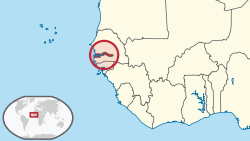The Gambia
The Gambia is officially called the Republic of the Gambia. This country is also known as Gambia.[5] It is a country in West Africa. It is surrounded by Senegal. It is the smallest country on mainland Africa.
Republic of the Gambia | |
|---|---|
| Motto: "Progress, Peace, Prosperity" | |
| Anthem: For The Gambia Our Homeland | |
 Location of the Gambia (dark red area within circle) on the coast of West Africa. | |
| Capital | Banjul 13°28′N 16°36′W / 13.467°N 16.600°W |
| Largest city | Serekunda |
| Official languages | English |
| National languages | List:
|
| Ethnic groups (2003) | |
| Demonym(s) | Gambian |
| Government | Presidential republic |
| Adama Barrow | |
| Isatou Touray | |
| Legislature | National Assembly |
| Area | |
• Total | 11,295 km2 (4,361 sq mi) (164th) |
• Water (%) | 11.5 |
| Population | |
• 2017 estimate | 2,051,363[1] (146) |
• 2013 census | 1,857,181 |
• Density | 176.1/km2 (456.1/sq mi) (74th) |
| GDP (PPP) | 2017 estimate |
• Total | $3.582 billion[2] |
• Per capita | $1,686[2] |
| GDP (nominal) | 2017 estimate |
• Total | $1.038 billion[2] |
• Per capita | $488[2] |
| Gini (2015) | medium |
| HDI (2018) | low · 174th |
| Currency | Dalasi (GMD) |
| Time zone | GMT |
| Driving side | right |
| Calling code | +220 |
| ISO 3166 code | GM |
| Internet TLD | .gm |


Banjul is the capital city.[6] The largest cities are Serekunda and Brikama.[7]
Geography
changeThe geography of Gambia is unusual. It is a long, thin country. Except for its coastline it is completely surrounded by the country of Senegal. The River Gambia flows from Senegal through its centre and into the Atlantic Ocean.
Climate
changeThe Gambia has a tropical climate. A hot and rainy season normally lasts from June until November.[8]
Politics and government
changeThe Gambia gained independence from the United Kingdom on 18 February 1965. It was ruled by Dawda Jawara and his People's Progressive Party (PPP) from 1965 to 1994. There was a military take-over in 1994. In 1996, Yahya Jammeh became president. Then in 2016, Adama Barrow was elected.
Administrative divisions
changeThe Gambia is divided into eight local government areas. They are:
As of 2013, these are then divided into 43 districts.
Culture
changeThe population of The Gambia is about 1.7 million. People from The Gambia are called Gambians. A number of people from different cultures and backgrounds live in The Gambia. Some of the largest groups are called Mandinka, Fula, Wolof and Jolo, in that order.
English is the official language, but people speak other languages as well.
Most Gambians follow the religion of Islam.
The American writer Alex Haley, who wrote the book Roots, found that his family came from The Gambia in the 1760s.
References
change- ↑ "The World Factbook: Gambia, The". CIA. Archived from the original on 2 July 2014. Retrieved 2 January 2018.
- ↑ 2.0 2.1 2.2 2.3 "The Gambia". International Monetary Fund.
- ↑ "GINI index (World Bank estimate) - Data". data.worldbank.org. Archived from the original on 21 April 2018. Retrieved 21 April 2018.
- ↑ "Human Development Report 2019". United Nations Development Programme. 10 December 2019. Archived from the original (PDF) on 23 May 2020. Retrieved 10 December 2019.
- ↑ There is variability in the use of the definite article, and whether it is capitalized. The British Permanent Committee on Geographical Names notes, We do have a letter dated May 1964 from the Gambian prime minister's office which instructed us that it should be The Gambia with a capital T. One of the reasons they gave was that Gambia could be confused with Zambia, which was a new name to the international community at the time.[1] However, in running text the present Gambian government generally does not capitalize the "the", and in captions it drops the "the" altogether.[2] Archived 2009-12-29 at the Wayback Machine
- ↑ "Banjul | national capital, The Gambia". Encyclopedia Britannica. Retrieved 7 April 2020.
- ↑ "Population of Cities in Gambia (2019)". Archived from the original on 2017-05-15. Retrieved 2020-04-28.
- ↑ Hayward, Derek; J. S. Oguntoyinbo (1987). Climatology of West Africa. Lanham, Maryland: Rowman & Littlefield. p. 189. ISBN 978-0-389-20721-4.
Other websites
change

